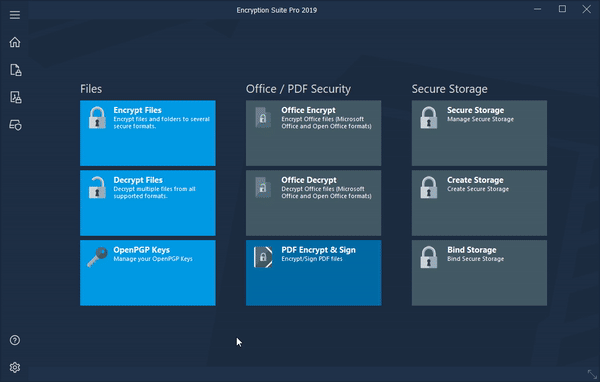Table of Contents
Encrypting Files
Visual Tutorial

How to Encrypt Files
Please start Encryption Suite Pro and click the Encrypt Files button located in the Files section of the main screen. The Encrypt interface will then appear. To add files to the encrypted archive, click the Files button, locate the files you would like to add to your encrypted archive, select them and click Open. The selected files will be added to the tracklist for creating the encrypted archive. To add a folder to the encrypted archive click the Folder icon and select the folder you wish you add. Once you select it, the folder will be added to the tracklist and is ready for encryption. You may add more than one folder to your encrypted archive.
The Destination Files section of that window works as follows:
- Group Into Single file - when selected, all files and folders in the tracklist will be placed in one encrypted archive.
- Encrypt Individually - when selected, each file and folder will be placed in a separate encrypted archive.
Destination Format section allows you to choose the format of your encrypted archive. Various formats are included. Keep in mind that the Zip format is the most commonly used format and is the format that most other compression software can open. This is important to know when sending encrypted .Zip files to clients/colleagues. The .PA format features strongest compression in combination with speed and can only be opened by PowerArchiver.
Encryption Options and Compression Options tabs, below the format choices, will allow you to configure various options in regards to how your encrypted archive is created. Please note that using the Deflate method of compression will make your encrypted .zip archive compatible with almost all other compression programs.
Destination Folder section works as follows:
- File's current folder - When selected, the encrypted archive will be saved into the current folder of the original file or files that are being encrypted.
- Custom Folder - when selected, you may choose a destination folder where your archive or archives will be saved.
After configuring the above options and selecting the file(s) you wish to encrypt, click the Encrypt button and you will be taken to the password input window. There, you will be asked to enter your password twice and please note the password requirements shown below the password entrance fields. Once the proper password is entered, click OK and the encrypted archive will be created.
Please Note:
This tutorial approaches the topic using the main PowerArchiver window as its base of operations. Classic interface is used to explain basic usage - if you are using Modern interface, you can change it to Classic interface by going to the Options tab and clicking on the Interface icon.